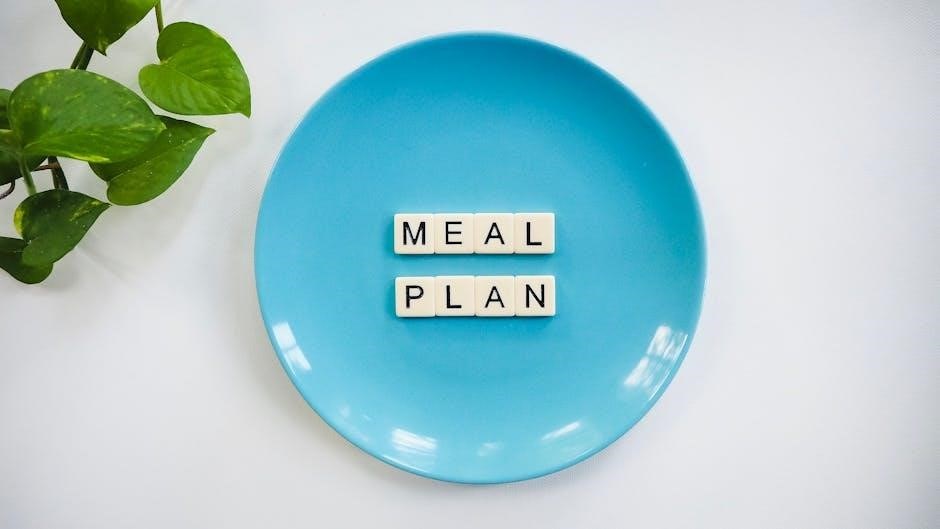The Lilly Diabetes Meal Planning Guide offers a comprehensive approach to managing blood sugar through personalized nutrition plans, balancing carbs, proteins, and fats, and incorporating delicious, nutrient-dense meals for better health.
Overview of the Lilly Diabetes Meal Planning Guide
The Lilly Diabetes Meal Planning Guide is a comprehensive resource designed to help individuals with diabetes manage their condition through structured and balanced nutrition. It provides detailed insights into creating personalized meal plans, emphasizing the importance of portion control, and understanding the glycemic index. The guide also offers practical tools, such as food lists and serving size recommendations, to simplify daily meal preparation. By focusing on nutrient-dense foods and avoiding hidden sugars, the guide helps users maintain stable blood sugar levels. Additionally, it addresses specific dietary needs for different types of diabetes, ensuring a tailored approach for each individual. The Lilly Diabetes Meal Planning Guide is a valuable tool for anyone seeking to improve their health and well-being through informed food choices.
Benefits of Effective Meal Planning for Diabetes Management
Effective meal planning is a cornerstone of diabetes management, offering numerous benefits for overall health and well-being. It helps stabilize blood sugar levels, preventing extreme highs and lows that can lead to complications. By structuring meals around balanced nutrition, individuals can achieve and maintain a healthy weight, reducing the risk of diabetes-related conditions like heart disease. Meal planning also promotes better energy levels and mental clarity, as consistent blood sugar control minimizes fatigue and brain fog. Additionally, it reduces reliance on medications by addressing the root cause of blood sugar imbalances. Perhaps most importantly, effective meal planning empowers individuals to take control of their health, fostering confidence and independence in managing their condition. Over time, these habits can lead to long-term improvements in health outcomes and quality of life.

Understanding the Basics of Diabetes Meal Planning
Diabetes meal planning focuses on balancing carbs, proteins, and fats to maintain blood sugar levels, emphasizing portion control and mindful eating to support overall health and glucose stability.
Key Food Groups for a Balanced Diabetes Diet
A balanced diabetes diet focuses on several key food groups to help manage blood sugar levels and promote overall health. These include:
- Non-starchy vegetables, such as broccoli, spinach, and bell peppers, which are low in calories and carbs but rich in fiber and nutrients.
- Lean proteins, like chicken, turkey, fish, and plant-based options like beans and lentils, to help stabilize blood sugar and provide energy.
- Whole grains, such as quinoa, brown rice, and whole-grain bread, which offer sustained energy and fiber compared to refined grains.
- Healthy fats, including avocados, nuts, and olive oil, to support heart health and satisfy hunger without spiking blood sugar.
- Low-sugar fruits, like berries, citrus fruits, and apples, which provide natural sweetness and essential vitamins.
These food groups help create a balanced meal plan that supports blood sugar control and overall well-being for individuals with diabetes.

Understanding the Glycemic Index and Its Impact on Blood Sugar
The Glycemic Index (GI) is a crucial tool for managing blood sugar levels, measuring how quickly foods raise blood glucose. Foods are ranked on a scale from 0 to 100, with pure glucose at 100. Low-GI foods, such as whole grains, non-starchy vegetables, and legumes, digest slowly, causing gradual blood sugar increases. High-GI foods, like white bread and sugary snacks, lead to rapid spikes. Incorporating low-GI foods into meals helps stabilize blood sugar, reducing the risk of sharp fluctuations. This approach is particularly beneficial for individuals with diabetes, as it supports better glycemic control and overall health. By understanding and selecting foods with a lower GI, individuals can make informed dietary choices to manage their condition effectively.

Meal Planning Fundamentals
Meal planning involves creating balanced, nutritious meals that align with dietary goals, focusing on portion control, food variety, and balanced macronutrients to support blood sugar management and overall health effectively.
How to Create a Personalized Meal Plan
Creating a personalized meal plan involves assessing your dietary needs, lifestyle, and health goals. Start by consulting with a healthcare provider or dietitian to set realistic targets for carbohydrate, protein, and fat intake. Use food lists and templates to organize your meals, ensuring balance and variety. Consider your daily schedule and preferences when selecting recipes. Focus on nutrient-dense foods, such as whole grains, lean proteins, and non-starchy vegetables, while limiting added sugars and refined carbs. Track your blood sugar levels and adjust portions as needed. Regularly review and update your plan to maintain motivation and ensure it aligns with your progress. A well-tailored meal plan not only helps manage blood sugar but also supports overall well-being and long-term health goals.
Portion Control and Serving Sizes

Portion control and understanding serving sizes are crucial for effective diabetes management. A serving size is a standard amount of food, while a portion is the amount you actually eat. Using measuring cups or a food scale can help you accurately measure portions. Visual guides, like comparing foods to everyday objects (e.g., a deck of cards for protein portions), can also be helpful. Pay attention to food labels, which provide serving sizes and nutritional information. Overeating even healthy foods can affect blood sugar levels, so sticking to recommended portions is key. A registered dietitian can help create a personalized plan tailored to your needs, ensuring balanced meals that align with your diabetes goals. Regularly tracking your intake and adjusting portions based on blood sugar readings can further refine your approach. Consistency and awareness are essential for maintaining control and promoting overall health.

Advanced Strategies for Managing Blood Sugar Through Diet
Advanced strategies involve balancing carbohydrates, proteins, and fats to stabilize blood sugar levels, while also identifying hidden sugars in foods to maintain better glycemic control and overall health.
Balancing Carbohydrates, Proteins, and Fats
Balancing carbohydrates, proteins, and fats is crucial for blood sugar control. Carbohydrates affect blood sugar most, so portion control is key. Protein and healthy fats slow digestion, reducing sugar spikes. Pairing carbs with protein and fats helps stabilize blood sugar levels. Choose whole, unprocessed foods to maximize nutrient intake and minimize glycemic impact. Incorporate lean proteins like poultry, fish, and legumes, and healthy fats like avocados and nuts. Avoid processed foods high in hidden sugars and unhealthy fats. A balanced plate should include a variety of colorful vegetables, whole grains, lean proteins, and a small portion of healthy fats. This approach supports overall health and makes managing diabetes easier and more sustainable. Regularly consulting with a dietitian or using meal planning tools can help create personalized balanced meals. By focusing on nutrient-dense foods and proper portion sizes, individuals can achieve better blood sugar control and improved overall well-being. Consistency in meal planning is essential for long-term success.
Identifying and Avoiding Hidden Sugars in Foods
Hidden sugars in foods can sabotage blood sugar control. Many processed foods, even savory ones, contain added sugars under names like high-fructose corn syrup, maltodextrin, or dextrose; Always read nutrition labels carefully to spot these. Focus on whole, unprocessed foods like vegetables, lean meats, and whole grains, which naturally have less sugar. Avoid sugary drinks, as they are major sources of hidden sugars. Limit foods with more than 8 grams of added sugar per serving. Choose unsweetened versions of products like yogurt or applesauce. Be mindful of condiments, sauces, and dressings, which often contain hidden sugars. Opt for homemade alternatives to avoid unnecessary sugar intake. Pairing protein or healthy fats with carb-rich foods can also help reduce the impact of hidden sugars. By being vigilant about hidden sugars, individuals can make healthier choices aligned with their diabetes management goals. This practice supports better blood sugar control and overall health;

Special Considerations in Diabetes Meal Planning
Managing diabetes requires tailored approaches for different needs, such as gestational diabetes, holidays, or special events. Personalized meal plans help balance enjoyment with blood sugar control, ensuring flexibility and health.
Meal Planning for Different Types of Diabetes (Type 1, Type 2, Gestational)
The Lilly Diabetes Meal Planning Guide provides tailored strategies for various types of diabetes. For Type 1 diabetes, the focus is on precise carbohydrate counting and insulin management to maintain stable blood sugar levels. Type 2 diabetes meal plans emphasize balanced macronutrient intake, portion control, and heart-healthy choices to support weight management and glucose regulation. Gestational diabetes requires careful monitoring of carbohydrate and sugar intake, prioritizing whole, nutrient-dense foods to manage blood sugar spikes during pregnancy. Each plan is designed to address unique needs, ensuring personalized approaches for effective diabetes management. By understanding the specific dietary requirements for each type, individuals can create meals that promote better health outcomes and overall well-being. This guide helps individuals navigate these differences with practical, actionable advice tailored to their condition.
Managing Diabetes Through Meal Planning During Special Occasions and Holidays
Special occasions and holidays can be challenging for individuals with diabetes, but proper meal planning ensures enjoyable and healthy celebrations. The Lilly Diabetes Meal Planning Guide offers strategies to balance indulgence with blood sugar control. Focus on portion control, opting for smaller servings of festive foods while prioritizing nutrient-dense options. Plan ahead by identifying healthier alternatives or modifying traditional recipes to reduce sugar and carbohydrate content. Pairing carbohydrates with proteins and fats can help stabilize blood sugar levels. The guide also suggests creating a pre-meal plan to avoid overeating and incorporating physical activity to offset calorie intake. By balancing indulgence with mindful choices, individuals can enjoy holidays without compromising their diabetes management. The guide provides practical tips to navigate these situations, ensuring that special occasions remain joyful and stress-free while maintaining health goals.

Resources and Tools for Effective Meal Planning
The Lilly Diabetes Meal Planning Guide provides essential tools, including food lists, customizable templates, and mobile apps, to help individuals plan and track their meals effectively for better blood sugar management.
Food Lists and Meal Planning Templates
Food lists and meal planning templates are essential tools for organizing and tracking daily nutrition; They help individuals identify healthy food options, portion sizes, and meal combinations that align with dietary goals. By categorizing foods into groups such as carbohydrates, proteins, and fats, these lists simplify the process of creating balanced meals. Templates provide a structured format for planning meals in advance, ensuring variety and adherence to nutritional guidelines. They also serve as a reference for grocery shopping, reducing the likelihood of unhealthy impulse purchases. Utilizing these resources enables individuals to maintain consistency in their eating habits, which is crucial for managing conditions like diabetes effectively. Over time, these tools can help foster healthier eating patterns and improve overall well-being.

Technology and Apps for Diabetes Meal Planning
Technology and apps have revolutionized diabetes meal planning by providing innovative tools to track and manage nutrition. Apps like MyFitnessPal and MyNetDiary allow users to log meals, track calories, and monitor carbohydrate intake, essential for blood sugar control. Some apps, such as Plan & Eat or Yummly, offer personalized meal planning based on dietary preferences and health goals. They provide recipe suggestions, grocery lists, and nutritional insights, making it easier to adhere to a balanced diet. Additionally, apps like Carb Manager are specifically designed for diabetes management, offering detailed carb counting and integration with glucose tracking devices. These tools empower individuals to make informed food choices and maintain consistency in their eating habits. By leveraging technology, users can streamline meal planning, ensuring their dietary needs are met while managing diabetes effectively. These digital solutions are invaluable for those seeking to simplify and enhance their nutrition management journey.

The Lilly Diabetes Meal Planning Guide empowers individuals to manage their condition effectively through tailored nutrition plans, emphasizing balanced eating and informed food choices for improved health and well-being.
Effective diabetes meal planning involves creating personalized plans, understanding food groups, and balancing carbs, proteins, and fats. Portion control and monitoring the glycemic index are crucial. Avoid hidden sugars and use tools like food lists and apps for better management. Regular adjustments ensure sustained blood sugar control and overall health.
Encouragement and Next Steps for Continuous Learning
Congratulations on completing the Lilly Diabetes Meal Planning Guide! You’ve taken a significant step toward managing your diabetes through informed nutrition. Continuous learning is key to long-term success. Explore new recipes, stay updated on the latest research, and engage with diabetes communities for shared experiences. Utilize tools like food tracking apps and consult with healthcare professionals to refine your plan. Set realistic goals and celebrate small victories along the way. Remember, meal planning is a journey, and every effort counts toward better health. Keep experimenting with flavors and ingredients to maintain variety while staying on track. With persistence and the right resources, you can master diabetes meal planning and enjoy a balanced, fulfilling diet.
